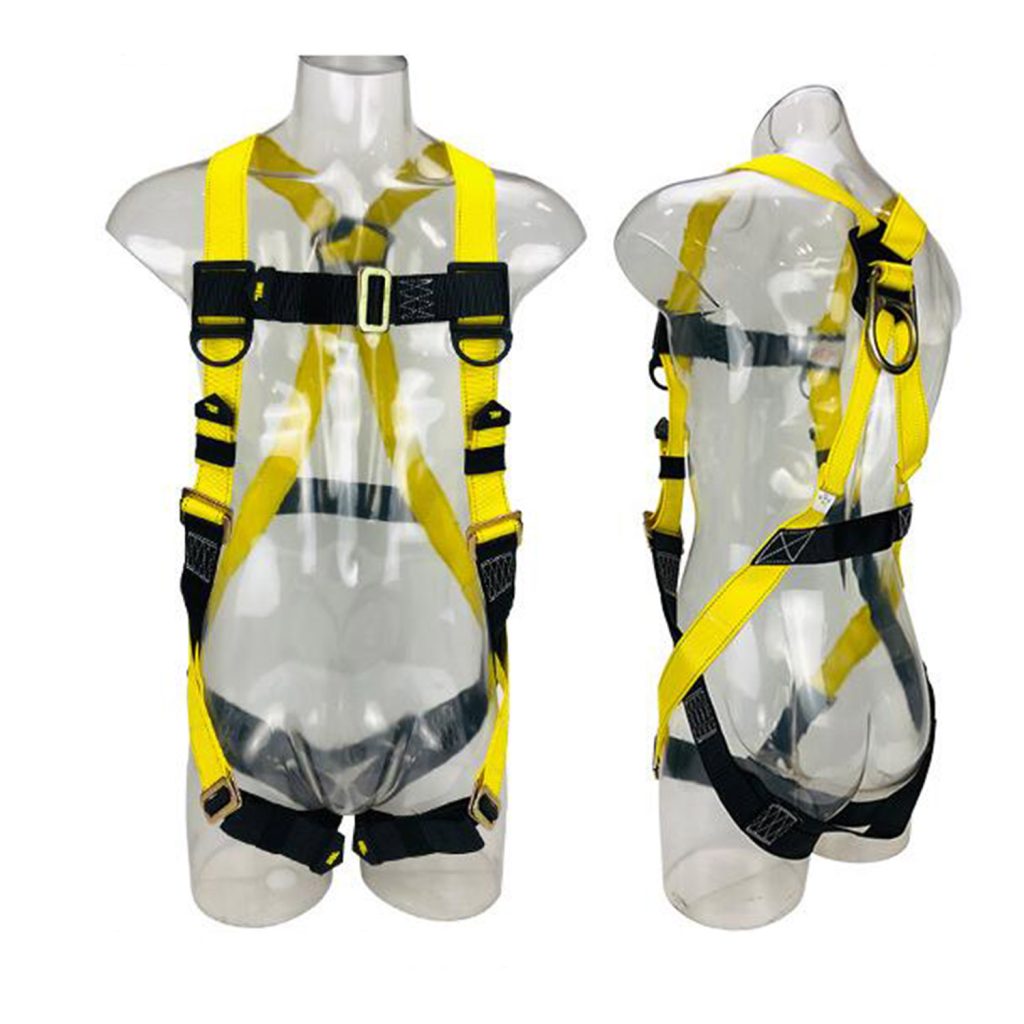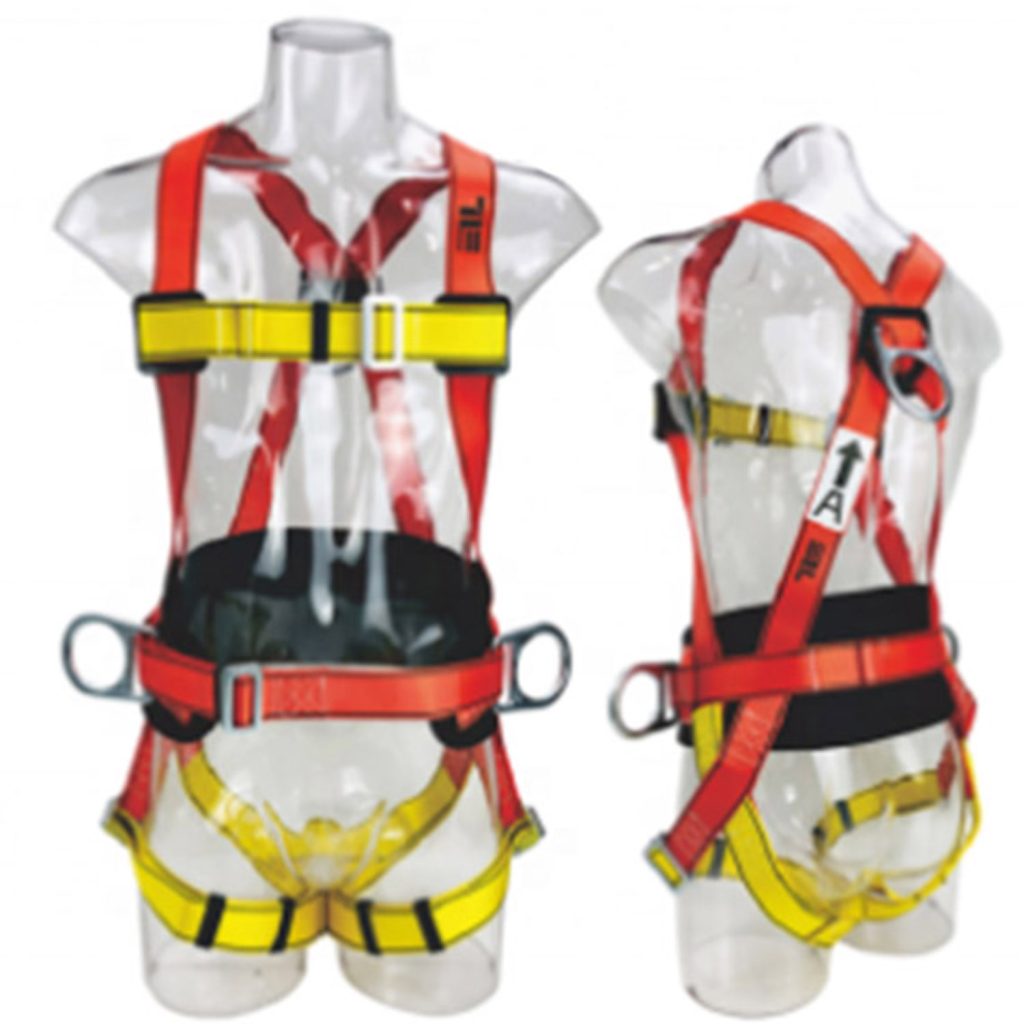The importance of a full-body harness cannot be overstated when it comes to ensuring your safety in various work environments. Whether you’re working at heights, on construction sites, or in other high-risk situations, a properly worn harness is your lifeline. This essential piece of equipment serves as your last line of defense against potentially life-threatening falls and accidents.

What is a body harness and how does it work?
A body harness is a safety device designed to protect you when working at heights or in risky environments. It’s like a wearable shield that keeps you secure. Here’s how it works:
Wearable Protection: A body harness is worn like a piece of clothing. It’s made of straps that fit around your body securely.
Distribution of Forces: If you fall, the harness spreads the force of the impact across your body, reducing the risk of injury.
Attachment Points: It has attachment points where you can connect safety lanyards or lifelines. These keep you connected to an anchor point, preventing falls.
Proper Fit: A snug fit is crucial for the harness to work effectively. It should be adjusted to your body size to prevent slipping.
Fall Arrest: In a fall, the harness stops you from hitting the ground. The energy-absorbing lanyards or shock absorbers reduce the impact force.
Safety Regulations: Using a body harness is essential in many industries and is often mandated by safety regulations.
Training: Proper training on how to wear and use a harness is vital. It ensures you know how to stay safe while working at heights.
Body harnesses are used in construction, window cleaning, rescue operations, and more. They provide a secure and reliable way to prevent accidents when working in elevated or dangerous settings.
Types of Full Body Safety Harnesses
Full body safety harnesses come in various types, each designed for specific purposes to ensure maximum safety in various work environments. Let’s explore five common types:
Construction Harness
Purpose: Ideal for construction workers, it features numerous attachment points, D-rings, and adjustable straps.
Use: Used in construction settings, it provides multiple connection options for various equipment.
Fall Arrest Harness
Purpose: Specifically designed to stop falls in progress and minimize the impact on the body.
Use: Used in situations where falling from heights is a risk, such as roofing or tower work.
Rescue Harness
Purpose: Geared towards rescue and emergency response teams, it includes additional attachments for carrying tools or rescue equipment.
Use: Ideal for situations where quick access to rescue gear is crucial, such as confined space rescues.
Climbing Harness
Purpose: Designed for rock climbers and mountaineers, it prioritizes comfort and mobility.
Use: Used during recreational climbing or in professional mountaineering expeditions.
Tower Harness
Purpose: Tailored for telecom and utility workers who often work on towers or poles.
Use: Provides secure attachments and extra comfort for long hours spent at elevated heights.
Each type of full body safety harness is engineered with specific features to meet the unique demands of various industries and activities.
Basic Components of a Full Body Safety Harness
A full-body safety harness is a crucial piece of equipment for anyone working at heights or in hazardous environments. It provides essential protection and support to prevent falls and injuries. Understanding the basic components of a full-body safety harness is vital for your safety.
Shoulder Straps: These are like the harness’s backbone, running over your shoulders and connecting to the chest and back D-rings. They distribute the weight evenly.
Chest Strap: This strap secures the shoulder straps across your chest, ensuring that the harness stays in place during a fall.
Leg Straps: These straps go around your thighs, preventing you from slipping out of the harness in case of a fall.
Waist Belt: The waist belt wraps around your waist and provides additional support and stability.
D-rings: These are metal rings located on the front and back of the harness. They serve as anchor points for connecting lanyards or lifelines.
Buckles: Buckles are used to fasten the harness securely. They are usually quick-release for easy removal in emergencies.
Adjustment Points: These are typically found on the shoulder, chest, and leg straps. They allow you to customize the fit of the harness for maximum comfort and safety.
Pads and Cushioning: Some harnesses come with padding or cushioning on the straps to increase comfort during prolonged use.
Fall Arrest Indicator: This is a visual indicator that shows whether the harness has been subjected to a fall. If it has, the harness may need to be replaced.
Attachment Points: These are where you connect your lanyards, lifelines, or other fall protection equipment. The front D-ring is for work positioning, and the back D-ring is for fall arrest.
Quick Connectors: These are used to attach lanyards and other safety devices to the D-rings quickly and securely.
Load Indicator: Some harnesses have a load indicator that helps you assess the forces experienced during a fall. If it shows signs of damage, the harness should be replaced.
Materials: Full-body safety harnesses are made from durable materials like nylon or polyester webbing, which are strong and resistant to wear and tear.

How to use full body harness?
Using a full-body harness properly is crucial for safety when working at heights or in dangerous environments. In this step-by-step guide, we’ll walk you through how to use a full-body harness effectively.
Step 1: Select the Right Harness
Choose a harness that is appropriate for your specific job and needs. Consider factors like weight capacity, size, and comfort.
Step 2: Inspect the Harness
Before each use, inspect the harness thoroughly. Check for any signs of damage, wear, or fraying on the straps, buckles, and D-rings.
Step 3: Put on the Harness
Stand in the middle of the harness and step into the leg loops, like putting on a pair of pants.
Pull the harness up over your shoulders, ensuring that the shoulder straps rest comfortably on each shoulder.
Step 4: Fasten the Waist Belt
Connect the waist belt buckle securely, making sure it is properly aligned and locked into place.
Step 5: Adjust the Fit
Tighten the shoulder straps to eliminate any slack but ensure they are not too tight to restrict your movement or breathing.
Adjust the chest strap snugly across your chest, just below your collarbone.
Tighten the leg straps so they fit snugly but comfortably around your thighs.
Step 6: Check for Comfort
Move around and check if the harness is comfortable. It should not bind, chafe, or restrict your movement.
Step 7: Inspect D-ring Connections
Ensure that the front and back D-rings are properly connected, and there are no twists or tangles in the straps.
Step 8: Attach Lanyards and Lifelines
Connect your lanyards or lifelines to the D-rings on the harness. Use appropriate connectors and make sure they are secure.
Step 9: Verify Connections
Double-check all connections to ensure they are properly locked and secured.
Step 10: Perform a Function Check
Before starting work, perform a function check by applying light pressure to your fall protection equipment to ensure it engages correctly.
Step 11: Begin Your Work
Once you’ve verified that everything is secure and functional, you can begin your work at heights or in a hazardous environment.
Step 12: Stay Alert and Safe
While working, stay aware of your surroundings and any potential hazards.
Avoid sudden movements or jerking actions that could put extra stress on your harness.
Step 13: Keep Straps Adjusted
Periodically check your harness during work to ensure that straps remain snug and secure.
Step 14: Descending or Climbing
If your job involves climbing or descending, make sure to follow proper techniques and maintain a secure connection to your fall protection equipment.
Step 15: Inspect Regularly
Regularly inspect your harness for wear and tear, especially after a fall or heavy use. Replace any damaged components immediately.
Step 16: Store Properly
Store your harness in a cool, dry place away from direct sunlight, chemicals, or extreme temperatures.
Step 17: Follow Manufacturer’s Instructions
Always follow the manufacturer’s instructions and guidelines provided with your harness.
Using a full-body harness correctly is vital to your safety. Following these steps will help ensure that you are properly secured while working at heights or in hazardous conditions. Remember that regular inspections and maintenance are essential to keep your harness in top condition and ready for use.
 ZIMAI Safety
ZIMAI Safety